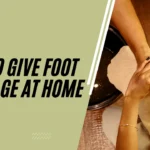If you’re dealing with tight calves, heel pain, or discomfort around the back of your ankle, learning how to massage the Achilles tendon the right way can support better mobility and recovery. When done safely, Achilles tendon massage may help reduce muscle tension, improve blood flow, and support your body’s natural healing process.
Important: If you have severe pain, swelling, a sudden “pop,” bruising, or suspect a torn Achilles tendon, stop and see a doctor or physical therapist immediately before trying any massage.
What Is the Achilles Tendon and Why Does It Hurt?
The Achilles tendon is a strong band of tissue that connects your calf muscles (gastrocnemius and soleus) to your heel bone (calcaneus). It helps you walk, run, jump, and push off the ground.
Common issues related to Achilles pain include:
- Achilles tendinitis / tendonitis
- Achilles tendinopathy
- Calf muscle tightness
- Plantar fasciitis
- Overuse from running or sports
- Improper footwear or sudden increase in activity
Gentle, targeted Achilles tendon self-massage can be a helpful part of a complete care plan recommended by a healthcare professional.
Safety Tips Before You Massage the Achilles Tendon
Before you begin your Achilles tendon massage, keep these safety guidelines in mind:
- Avoid massaging directly over sharp, burning, or severe pain
- Do not massage if there is visible swelling, redness, or warmth
- Avoid massage after a recent injury or suspected tear
- Stop immediately if the pain gets worse
- When in doubt, ask a doctor, sports physician, or physical therapist
If you’re under the care of a professional, massage can complement treatments like physical therapy, deep tissue work, or sports massage. For example, a targeted session like Sports Massage Tysons Corner can be helpful for active clients with recurring leg and ankle tension.
Step-by-Step: How to Massage the Achilles Tendon
Follow these basic steps for a gentle, at-home Achilles tendon self-massage:
1. Warm Up the Area
- Sit comfortably with your leg extended and heel supported.
- Use a warm towel or warm shower for 5–10 minutes on your calf and Achilles tendon.
- Lightly move your ankle up and down to increase circulation.
This helps relax the calf muscles and prepares the Achilles tendon for deeper work.
2. Apply a Small Amount of Oil or Lotion
- Use a little massage oil, cream, or lotion so your fingers glide smoothly.
- Avoid using too much product so you still have some grip on the tissue.
This reduces skin friction and allows you to focus on the tendon and surrounding muscles.
3. Gentle Effleurage (Warming Strokes)
- Place your fingers or thumbs along the back of your ankle and lower calf.
- Using long, gentle strokes, glide from the heel upward toward the calf.
- Maintain light to moderate pressure—about 3–5 minutes.
This technique, called effleurage, helps promote blood flow and warms the tissue around the Achilles tendon.
4. Cross-Fiber Massage on the Achilles Tendon
Cross-fiber friction is a common technique used in sports massage and physical therapy:
- Locate the Achilles tendon at the back of your heel.
- Using one or two fingers, press gently across the tendon (side-to-side, not up and down).
- Perform slow, controlled strokes for 1–2 minutes.
You might feel slight discomfort, but it should never be sharp or unbearable. If it is, stop.
5. Calf Muscle Massage to Reduce Tendon Stress
Tight gastrocnemius and soleus muscles can overload the Achilles tendon. To relax them:
- Use your thumbs to apply pressure into your calf muscles.
- Work from the ankle upward toward the back of the knee.
- Use circular motions and long strokes for 3–5 minutes.
Releasing calf tension often reduces pulling on the Achilles tendon and improves overall ankle flexibility. Many people also benefit from focused leg work like a Deep Tissue Massage Tysons Corner session to address chronic tightness in the calves and lower legs.
6. Gentle Ankle Mobility After Massage
After your Achilles tendon massage, gently move the joint:
- Slowly flex and point your toes
- Make small ankle circles
- Perform light calf stretches (if pain-free)
These range-of-motion exercises help the tissue adapt to massage and encourage healthy movement patterns.
For additional support to feet and lower legs, you may also explore Reflexology Massage, which focuses on pressure points in the feet and can complement Achilles tendon care.
How Often Should You Massage Your Achilles Tendon?
Frequency depends on your body and overall condition:
- For mild tightness: 3–5 times per week, using gentle pressure
- For maintenance: 1–2 times per week alongside stretching and strengthening
- Always reduce frequency or intensity if symptoms worsen
For ongoing or sports-related issues, consult with a physical therapist, podiatrist, or sports medicine specialist for a complete treatment plan.
If you’re in Tysons Corner, VA and need professional help, you can explore all our massage services in Tysons Corner to find the right session to support your recovery.
When You Should Not Massage the Achilles Tendon
Avoid Achilles tendon massage and seek medical advice if:
- You heard or felt a “pop” in the back of your ankle
- You cannot push off the ground or walk properly
- There is strong, sudden pain with swelling or bruising
- You have suspected Achilles tendon rupture
- You have uncontrolled medical conditions affecting circulation or nerves
In these cases, self-treatment is not recommended and professional assessment is essential.
FAQ: Common Questions About Massaging the Achilles Tendon
1. Is it OK to massage the Achilles tendon?
Yes, gentle Achilles tendon massage is usually safe for mild tightness or discomfort, but you should avoid massage if you suspect a tear, have severe pain, or notice major swelling. Always consult a healthcare professional if you’re unsure.
2. Can massage help Achilles tendinitis or tendinopathy?
Massage can support Achilles tendinitis by improving blood flow, easing muscle tension, and complementing a treatment plan. However, it should not replace medical advice, strengthening exercises, or physical therapy.
3. How much pressure should I use when massaging the Achilles tendon?
Use light to moderate pressure—enough to feel the tissue but not enough to cause sharp pain. If you start bracing or holding your breath, you’re pressing too hard.
4. How long should an Achilles tendon massage session last?
A typical self-massage session may last 5–10 minutes, including the calf muscles and ankle area. Longer sessions are best handled by a professional massage therapist.
5. Can I massage my Achilles tendon every day?
For mild tension, you may perform gentle massage daily or every other day. If you feel increased soreness or irritation, reduce frequency and talk to a professional.
6. What is the best technique to massage the Achilles tendon?
Common techniques include effleurage (long strokes), cross-fiber friction, and gentle calf muscle massage. These help relax the surrounding soft tissue and reduce tension on the tendon.
7. Should I use heat or ice before Achilles tendon massage?
Many people find heat helpful before massage to relax muscles and improve circulation. Ice may be used afterward if there is mild irritation, but avoid direct ice or massage on severe injuries without guidance.
8. Can massaging the Achilles tendon prevent injury?
Massage alone cannot guarantee prevention, but combined with stretching, strengthening, proper footwear, and rest, it can help support healthy tissue and reduce overall stiffness.
9. When should I see a doctor instead of massaging the Achilles tendon?
If you experience sudden, intense pain, a snapping sensation, difficulty walking, or heavy swelling, stop massage and see a doctor or sports medicine specialist immediately.
10. Is professional sports massage better than self-massage for Achilles pain?
A professional sports massage therapist or physical therapist can assess your gait, muscle imbalances, and tendon health, then apply targeted techniques. Self-massage is a useful supplement but not a replacement for expert care in more serious cases.






